Can I Grow Food Through the Winter?
Eating fresh garden vegetables has become such a hallmark of summer for us, we started to wonder what it would take to grow vegetables year-round. Winter doesn’t need to bring vegetable melancholy, nor the end to joyful gardening! We’ve decided to try an experiment and grow vegetables outside through the winter here in Durango, Colorado and we’re excited to have you along for the journey!
The Basics:
There are many different ways to grow food in the winter months and it can be hard to find information about the process. Industrial agriculture, (which is the basis for much of our predominant food culture in the U.S.), tells us to cut down crops and till the soil in the fall, leaving the ground barren through the cold months. This thought process says that vegetables will freeze in the cold and our efforts are better spent preserving food to eat through the winter (or shopping at the grocery store).
Now, there is some truth to this philosophy. Winter does bring colder temperatures to most of the country and vegetables do have limits on how much cold they can tolerate. But soils are depleted when left for long periods with nothing growing in them, which impacts the next growing season. And besides, we have plenty of tools we can utilize to work around cold constraints.
Today, we’ll take a quick dive into a few of the methods available and walk through some of the details of our current experiment.
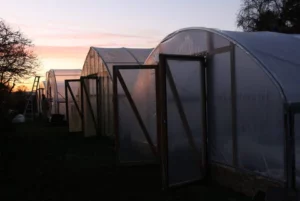
Photo: Floretflowers.com
The Greenhouse:
Many people think immediately of greenhouses when they ponder winter gardening. Vegetables need both ambient air and soil temperatures to stay within a certain range for healthy growing and greenhouses can achieve exactly that. The heated greenhouse can provide the land of luxury for cute little plants trying to stave off the cold, surrounding them with heat, sunlight, and a healthy dose of humidity. Even an unheated greenhouse can provide a comfy living situation for many plants.
But of course, not everyone has or can have a greenhouse. They take up space, they can be expensive to build and heat, and they require maintenance and care. If this is the case for you, never fear! There are so many different ways to extend growing seasons, ranging from building big structures down to growing a few types of herbs in pots on your kitchen window sill.
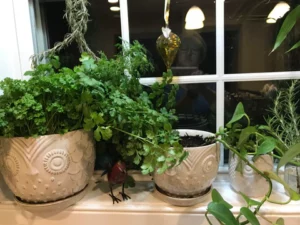
Winter Indoor Herb Garden, Photo: Tamara Cullaz
Key Principles:
There are creative solutions to every problem! When thinking through your winter growing goals, start by keeping the following pieces in mind:
- Your specific growing climate (temperature extremes, moisture, light)
- The specific type of plant(s) you want to grow (are they frost tolerant?)
- Your individual constraints and opportunities (what resources are available to you?)
Our Experiment: the Caterpillar Tunnel
Based on our evaluation of the principles above, we’ve decided to experiment at home with low “caterpillar” tunnels this year. Our Durango backyard is pretty average-sized, with one section that gets consistent sun. We rent and didn’t want to invest a lot of money into our winter growing situation, nor build any permanent structures.
With a ton of help from Susan and Dean at Brightwood Farm in Hermosa, we’ve decided to use a Caterpillar Tunnel method with low hoops inside. Susan and Dean have developed their system through lots of research and trial and error, and we’re excited to adapt it to our backyard.
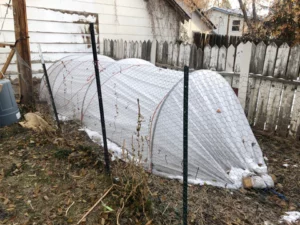
The Caterpillar Tunnel
This method essentially creates a double chamber of air, which makes a buffer zone between the plants and the cold air outside. We planted in two main rows, which are each covered with row cover material, stretched over thick wire that’s bent into a hoop shape. These two rows are positioned right next to each other so that we could fit taller, beefier hoops over them. These hoops are covered with thick plastic and tightened down to the ground with twine and anchored at each end.
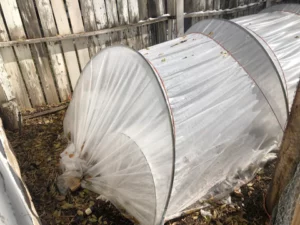
Interior and Exterior Hoops
The basic idea of the system is that the two layers of air “bubbles” will provide enough of a buffer zone to keep heat loss at the plants level reasonable enough for them to grow. When cold, windy air hits the plastic, it will have a cooling effect on the air immediately inside, but it won’t be able to instantly steal all of the heat away because the row covers provide an additional zone of insulation.
This is not a heated system, so we’ve planted only frost-tolerant vegetables. When it gets really cold here in Durango, our plants will feel the frost, and thaw out again during the heat of the day.
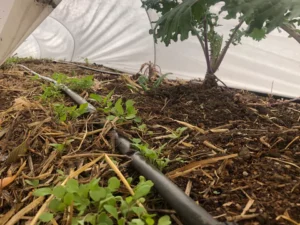
Drip Tape
We have installed drip tape down our rows for irrigation, which we used initially to water our seeds. We expect to water minimally throughout the winter and will instead rely on water recycling inside of the tunnels as it heats up during the day and then condenses on the ceiling and falls at night.
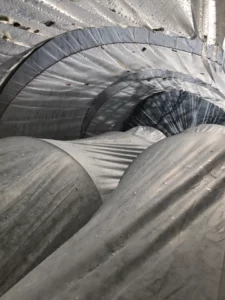
The Water Cycle in Action
We also expect that our vegetables won’t grow extremely tall through the winter, as they’ll be focusing on staying warm and viable, so we’re not worried about them out-growing their tunnels. Once consistent warm weather arrives, we will likely pull off the covers and let the plants grow to their desired heights. Hopefully our winter efforts will give us a jumpstart on the growing season.

Farao Cabbage at Brightwood Farm, transplanted 9/3, Photo: Susan Vidal
All in all, our materials cost us $80 (~$37 for irrigation), and we spent another $15 on organic, frost-tolerant seeds. This certainly isn’t pocket change, but it’s a very reasonable price given all the benefits. We planted 10 different varieties of kohlrabi, beets, arugula, kale, carrots, radishes, spinach, and mesclun lettuce. Not only will we be growing delicious, healthy veggies, we’ll also be nourishing our soil and supporting its microbes. If you want to learn more about the power of local food, check out our blog post here.
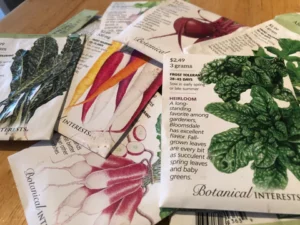
Seed Packets
